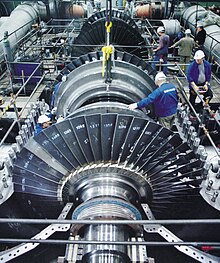 Power engineering, also called power systems engineering, is a subfield of energy engineering that deals with the generation, transmission and distribution of electric power as well as the electrical devices connected to such systems including generators, motors and transformers. Although much of the field is concerned with the problems of three-phase AC power - the standard for large-scale power transmission and distribution across the modern world - a significant fraction of the field is concerned with the conversion between AC and DC power as well as the development of specialized power systems such as those used in aircraft or for electric railway networks. It was a subfield of electrical engineering before the emergence of energy engineering.
Power engineering, also called power systems engineering, is a subfield of energy engineering that deals with the generation, transmission and distribution of electric power as well as the electrical devices connected to such systems including generators, motors and transformers. Although much of the field is concerned with the problems of three-phase AC power - the standard for large-scale power transmission and distribution across the modern world - a significant fraction of the field is concerned with the conversion between AC and DC power as well as the development of specialized power systems such as those used in aircraft or for electric railway networks. It was a subfield of electrical engineering before the emergence of energy engineering.Electricity became a subject of scientific interest in the late 17th century with the work of William Gilbert.[1] Over the next two centuries a number of important discoveries were made including the incandescent lightbulb and the voltaic pile.[2][3] Probably the greatest discovery with respect to power engineering came from Michael Faraday who in 1831 discovered that a change in magnetic flux induces an electromotive force in a loop of wire—a principle known as electromagnetic induction that helps explain how generators and transformers work.[4]
In 1881 two electricians built the world's first power station at Godalming in England. The station employed two waterwheels to produce an alternating current that was used to supply seven Siemens arc lamps at 250 volts and thirty-four incandescent lamps at 40 volts.[5] However supply was intermittent and in 1882 Thomas Edison and his company, The Edison Electric Light Company, developed the first steam-powered electric power station on Pearl Street in New York City. The Pearl Street Station consisted of several generators and initially powered around 3,000 lamps for 59 customers.[6][7] The power station used direct current and operated at a single voltage. Since the direct current power could not be easily transformed to the higher voltages necessary to minimise power loss during transmission, the possible distance between the generators and load was limited to around half-a-mile (800 m).[8]
That same year in London Lucien Gaulard and John Dixon Gibbs demonstrated the first transformer suitable for use in a real power system. The practical value of Gaulard and Gibbs' transformer was demonstrated in 1884 at Turin where the transformer was used to light up forty kilometres (25 miles) of railway from a single alternating current generator.[9] Despite the success of the system, the pair made some fundamental mistakes. Perhaps the most serious was connecting the primaries of the transformers in series so that switching one lamp on or off would affect other lamps further down the line. Following the demonstration George Westinghouse, an American entrepreneur, imported a number of the transformers along with a Siemens generator and set his engineers to experimenting with them in the hopes of improving them for use in a commercial power system.

One of Westinghouse's engineers, William Stanley, recognised the problem with connecting transformers in series as opposed to parallel and also realised that making the iron core of a transformer a fully enclosed loop would improve the voltage regulation of the secondary winding. Using this knowledge he built a much improved alternating current power system at Great Barrington, Massachusetts in 1886.[10] Then in 1887 and 1888 another engineer called Nikola Tesla filed a range of patents related to power systems including one for a two-phase induction motor. Although Tesla cannot necessarily be attributed with building the first induction motor, his design, unlike others, was practical for industrial use.[11]
By 1890 the power industry had flourished and power companies had built literally thousands of power systems (both direct and alternating current) in the United States and Europe - these networks were effectively dedicated to providing electric lighting. During this time a fierce rivalry known as the "War of Currents" emerged between Edison, Westinghouse and Tesla over which form of transmission (direct or alternating current) was superior. In 1891, Westinghouse installed the first major power system that was designed to drive an electric motor and not just provide electric lighting. The installation powered a 100 horsepower (75 kW) synchronous motor at Telluride, Colorado with the motor being started by a Tesla induction motor.[12] On the other side of the Atlantic, Oskar von Miller built a 20 kV 176 km three-phase transmission line from Lauffen am Neckar to Frankfurt am Main for the Electrical Engineering Exhibition in Frankfurt.[13] In 1895, after a protracted decision-making process, the Adams No. 1 generating station at Niagara Falls began transmitting three-phase alternating current power to Buffalo at 11 kV. Following completion of the Niagara Falls project, new power systems increasingly chose alternating current as opposed to direct current for electrical transmission.[14]
Although the 1880s and 1890s were seminal decades in the field, developments in power engineering continued throughout the 20th and 21st century. In 1936 the first commercial HVDC (high voltage direct current) line using Mercury arc valves was built between Schenectady and Mechanicville, New York. HVDC had previously been achieved by installing direct current generators in series (a system known as the Thury system) although this suffered from serious reliability issues.[15] In 1957 Siemens demonstrated the first solid-state rectifier (solid-state rectifiers are now the standard for HVDC systems) however it was not until the early 1970s that this technology was used in commercial power systems.[16] In 1959 Westinghouse demonstrated the first circuit breaker that used SF6 as the interrupting medium.[17] SF6 is a far superior dielectric to air and, in recent times, its use has been extended to produce far more compact switching equipment (known as switchgear) and transformers.[18][19] Many important developments also came from extending innovations in the information technology and telecommunications field to the power engineering field. For example, the development of computers meant load flow studies could be run more efficiently allowing for much better planning of power systems. Advances in information technology and telecommunication also allowed for much better remote control of the power system's switchgear and generators.














No comments:
Post a Comment